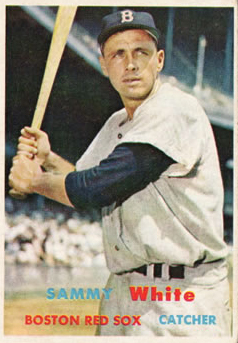June 18, 1953: Red Sox’ 17-run inning tames Tigers
 Baseball is different. Among the worldwide variety of “stick and ball” games, baseball (along with its cousins cricket and rounders) is different in that it is the player, and not the ball, which does the scoring—and the ball is often far away when the scoring is done. In field hockey, hurling, lacrosse, shinty, et. al., the ball itself is the scoring device.
Baseball is different. Among the worldwide variety of “stick and ball” games, baseball (along with its cousins cricket and rounders) is different in that it is the player, and not the ball, which does the scoring—and the ball is often far away when the scoring is done. In field hockey, hurling, lacrosse, shinty, et. al., the ball itself is the scoring device.
Moreover, in baseball, the defense controls the ball, and initiates the play. And it significantly outnumbers the offense — a nine vs. one proposition.
Finally, there is this from Roger Angell:
The last dimension is time. Within the ball park, time moves differently, marked by no clock except the events of the game. This is the unique, unchangeable feature of baseball, and perhaps explains why this sport, for all the enormous changes it has undergone in the past decade or two, remains somehow rustic, unviolent, and introspective. Baseball’s time is seamless and invisible, a bubble within which players move at exactly the same pace and rhythms as all their predecessors…Since baseball time is measured only in outs, all you have to do is succeed utterly; keep hitting, keep the rally alive, and you have defeated time. You remain forever young.[fn]Roger Angell, The Summer Game (Lincoln, Nebraska: The University of Nebraska Press, 1972).[/fn]
On Thursday, June 18, 1953, in front of 3,108 fans, the Boston Red Sox tested the truth of this proposition.[fn]“Detroit Tigers at Boston Red Sox Box Score and Play by Play.” Baseball Reference. June 18, 1953.[/fn]
The Red Sox, managed by Lou Boudreau, were 31-28 heading into this game, good enough for fourth place in the American League as play opened that day. The Tigers, though, managed by Fred Hutchinson, were a dismal 14-42, and in last place. Furthermore, the Tigers had been thrashed by the Red Sox 17-1 the previous day—a foreshadowing of things to come on this Thursday afternoon.[fn]“Detroit Tigers at Boston Red Sox Box Score and Play by Play.” Baseball Reference. June 17, 1953.[/fn]
The game began with veteran pitchers Ned Garver and Marv Grissom on the mound for the Tigers and Red Sox respectively. And through six innings, the Red Sox held the upper hand 5-3. While Walt Dropo had homered in the fourth inning for the Tigers, the Red Sox had strung together a series of walks and singles to score in the second and sixth innings to build that two-run lead.
The Tigers went one-two-three in the top of the seventh, set down by reliever Ellis Kinder on a foul fly, a strikeout, and a groundout. Now it was the Red Sox turn.
And what a turn it was.
It started innocently enough. Steve Gromek, who had entered the game to pitch in the sixth, gave up a single to Sammy White. This was followed by another single by Gene Stephens, which sent White to third. After Stephens swiped second, centerfielder Tom Umphlett hit a single to left field, plating both runners. Gromek then earned his first out, striking out Johnny Lipon.
Ten more Red Sox hitters would bat before the Tigers earned their second out. By then Gromek would be out of the game, having given way to Dick Weik after surrendering nine runs. In that string of ten batters, the Red Sox had three walks (one intentional), three singles, two doubles (including Stephens’ second hit of the inning), and a three-run home run by first baseman Dick Gernert.
After the second out, the Red Sox’ next eight batters each reached base via five singles (including Stephens’ third hit of the inning) and three walks. Six more runs scored in this time, including Sammy White’s third run of the inning.
Finally, blessedly, the Tigers’ Earl Harrist, their third pitcher of the inning, was able to induce George Kell (who also had made the second out) to hit a flyball to left field for the third out.
 In sum, the Red Sox had sent 23 hitters to the plate in the seventh, scoring 17 runs on 14 hits and six walks. They also left the bases loaded in this record-breaking inning. Wow!
In sum, the Red Sox had sent 23 hitters to the plate in the seventh, scoring 17 runs on 14 hits and six walks. They also left the bases loaded in this record-breaking inning. Wow!
The Tigers, perhaps shell-shocked at this point, were only able to manage three singles off Kinder the rest of the way to answer this Red Sox barrage of runs and hits. The game ended after 3:03 of play with the score Red Sox 23, Tigers 3. The woeful Tigers had given up 40 runs over their last two games—a true shellacking.
In his write-up of the game, Hy Hurwitz of the Boston Globe noted that
Sixteen all-time or modern major league baseball records were either toppled or tied in the process of humiliating the Tigers. (This must be a record for breaking or tieing records.)
Individually, Gene Stephens, Sammy White and Tom Umphlett featured the record manufacturing. Stephens became the first modern big leaguer to make three hits in the same inning. White scored three runs in the same inning to be the first major leaguer to score that many in an inning since 1900. Stephens, White and Umphlett each reached base safely three times in the historic seventh for another modern mark.[fn]Hy Hurwitz, “With 17 Run Inning, Red Sox Wallop Tigers 23-3.” Boston Globe. June 19, 1953.[/fn]
Along with this, though, the Red Sox had defeated time, at least until the Tigers were able to finally able to get them out in the seventh.
The Red Sox had so many baserunners that they were 15 for 27 with runners in scoring position, and left 13 men on base. And, it will come as no surprise that the seventh inning set an American League record for runs in an inning, a record that still stands.
There was a silver lining for the Tigers, though—the very next day, they signed Al Kaline.[fn]Scott Ferkovich, “When the Tigers gave up 17 Runs in One Inning.” detroitathletic.com. June 27, 2014.[/fn]
One last thing—The Red Sox did this without Ted Williams in the lineup.
Additional Stats
Boston Red Sox 23
Detroit Tigers 3
Fenway Park
Boston, MA
Box Score + PBP:
Corrections? Additions?
If you can help us improve this game story, contact us.

